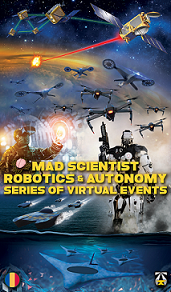[Editor’s Note: Mad Scientist is pleased to announce our latest episode of “The Convergence” podcast, featuring Dr. David Kilcullen — bestselling author, leading researcher in the field of unconventional and guerrilla warfare, former professional soldier and diplomat, and President and CEO of Cordillera Applications Group — discussing the future of conflict, changing concepts of victory, and achieving decisive advantages. Please note that this podcast and several of the embedded links below are best accessed via a non-DoD network due to network priorities for teleworking — Enjoy!]
[If the podcast dashboard is not rendering correctly for you, please click here to listen to the podcast]
 David Kilcullen is Professor of Practice at the Center on the Future of War and the School of Politics and Global Studies at Arizona State University, a Senior Fellow at New America, and an author, strategist, and counterinsurgency expert. He served 25 years as an officer in the Australian Army, diplomat and policy advisor for the Australian and United States Governments, in command and operational missions (including peacekeeping, counterinsurgency and foreign internal defense) across the Middle East, Southeast Asia, and Europe. In the United States, he was Chief Strategist in the State Department’s Counterterrorism Bureau, and served in Iraq as Senior Counterinsurgency Advisor to General David Petraeus, before becoming Special Advisor for Counterinsurgency to Secretary of State Condoleezza Rice. He is the author of a number of influential books including The Accidental Guerrilla: Fighting Small Wars in the Midst of a Big One, Counterinsurgency, Out of the Mountains, and Blood Year: The Unraveling of Western Counterterrorism — based on an essay that received the Walkley Award, the Australian version of the Pulitzer Prize. His newest book is The Dragons and the Snakes: How the Rest Learned to Fight the West.
David Kilcullen is Professor of Practice at the Center on the Future of War and the School of Politics and Global Studies at Arizona State University, a Senior Fellow at New America, and an author, strategist, and counterinsurgency expert. He served 25 years as an officer in the Australian Army, diplomat and policy advisor for the Australian and United States Governments, in command and operational missions (including peacekeeping, counterinsurgency and foreign internal defense) across the Middle East, Southeast Asia, and Europe. In the United States, he was Chief Strategist in the State Department’s Counterterrorism Bureau, and served in Iraq as Senior Counterinsurgency Advisor to General David Petraeus, before becoming Special Advisor for Counterinsurgency to Secretary of State Condoleezza Rice. He is the author of a number of influential books including The Accidental Guerrilla: Fighting Small Wars in the Midst of a Big One, Counterinsurgency, Out of the Mountains, and Blood Year: The Unraveling of Western Counterterrorism — based on an essay that received the Walkley Award, the Australian version of the Pulitzer Prize. His newest book is The Dragons and the Snakes: How the Rest Learned to Fight the West.
In today’s podcast, Dr. Kilcullen discusses the future of conflict, changing concepts of victory, and achieving decisive advantages. The following bullet points highlight key insights from our interview with him:
-
-
- Different actors (state and non-state) are converging on a set of tactics: small teams, modular, urban, use of cyber kinetics.
-
-
-
- This convergence is an adaptation to US and Western dominance in a small sub-set of warfare characterized by high tech, connected, exquisite systems of systems. We describe this as conventional or regular warfare because we are the best in the world at this type of conflict.
-
-
-
- These different actors are the Dragons (states) and Snakes (non-state actors). Dragons are back, but acting more like Snakes. Snakes are more capable due to the democratization of technology which makes them more lethal and capable of operating regionally and globally.
-
-
-
- The War on Terror is not over, but the period of large occupations has ended. Simultaneously, the possible resurgence of Great Power Conflict means the US must be capable of fighting both near peer competitors and capable non-state actors.
-
-
-
- The defining characteristics of future warfare include:
-
-
-
-
- Liminal Warfare – Our adversaries will seek to operate below the West’s response threshold, executing covert operations that may
 be detected, but whose sponsorship remains cloaked and unattributed; and ambiguous actions, where both the operation and sponsor may be suspected, but remain unproven.
be detected, but whose sponsorship remains cloaked and unattributed; and ambiguous actions, where both the operation and sponsor may be suspected, but remain unproven.
- Liminal Warfare – Our adversaries will seek to operate below the West’s response threshold, executing covert operations that may
-
-
-
-
-
- Tactical Concepts employing small teams, modular, swarming, empowered by advanced communications and (in the future) artificial intelligence.
-
-
-
-
-
- Blending cyber-kinetic operations. Cyber can no longer be viewed as a stand-alone tactic. Adversaries are using cyber to achieve lethal effects and using kinetic operations to degrade cyber, data, and communications infrastructures.
-
-
-
-
- What are we missing?
-
-
-
-
- Bio-weapons – adversaries have watched the impact of something like COVID on aircraft carriers, cruise ships, and aviation. Ground forces are less susceptible because they operate dispersed.
-
-
-
-
-
- Fighting unplugged – this should be the norm for U.S. Army training and exercises. BeiDou, China’s own GPS capability, is now fully operational and the PRC has developed a sophisticated Space warfare concept.
-
-
-
-
-
- Nuclear battlefield – with great power conflict comes the possibility of use of nuclear weapons on future battlefields. The Russians have a range of nuclear weapons that include sub-tactical munitions.
-
-

Stay tuned to the Mad Scientist Laboratory for our next episode of “The Convergence,” featuring Eli Dourado — an economist and Senior Research Fellow at the Center for
Growth and Opportunity at Utah State University — discussing significant technology areas in the next decade, the economic impact of shifting technology trends, and their impact on global security on 4 February 2021!
If you enjoyed this post, watch Dr. Kilcullen’s presentation on Sub-threshold conflict in a new age of Great-Power Competition in our Operational Environment and Conflict Over the Next Decade Webinar video [via a non-DoD network] and his associated slide deck.
… explore the U.S. Army’s single consistent Operational Environment narrative, spanning the near, mid-, and far terms out to 2050 in the following content:
Four Models of the Post-COVID World, The Operational Environment: Now through 2028, and The 2 + 3 Threat video
The Future Operational Environment: The Four Worlds of 2035-2050, the complete AFC Pamphlet 525-2, Future Operational Environment: Forging the Future in an Uncertain World 2035-2050, and associated video
… and check out the following related posts:
“Tenth Man” – Challenging our Assumptions about the Operational Environment and Warfare (Part 1) and (Part 2)
Blurring Lines Between Competition and Conflict
>>> REMINDER 1: We will facilitate the final webinar in our Mad Scientist Robotics & Autonomy Series of Virtual Events on Tuesday, 9 February 2021 (1300-1400 EST):
Frameworks (Ethics & Policy) for Autonomy on the Future Battlefield  — featuring subject matter experts from DARPA’s Defense Sciences Office and OSD’s Strategy and Force Development — will explore the ethical and policy considerations regarding autonomous systems on the future battlefield. Unmanned robotic and autonomous systems (both individual and swarming) will proliferate across the Operational Environment, presenting a host of opportunities and challenges for the U.S. Army. Join us in addressing these critical issues now so that the Army can incorporate insights into future force development and structuring.
— featuring subject matter experts from DARPA’s Defense Sciences Office and OSD’s Strategy and Force Development — will explore the ethical and policy considerations regarding autonomous systems on the future battlefield. Unmanned robotic and autonomous systems (both individual and swarming) will proliferate across the Operational Environment, presenting a host of opportunities and challenges for the U.S. Army. Join us in addressing these critical issues now so that the Army can incorporate insights into future force development and structuring.
In order to participate in this virtual event, you must first register here [via a non-DoD network].
>>> REMINDER 2: We have launched our Mad Scientist Writing Contest on Competition, Crisis, Conflict, and Change to crowdsource the intellect of the Nation (i.e., You!) regarding:

How will our competitors deny the U.S. Joint Force’s tactical, operational, and strategic advantages to achieve their objectives (i.e., win without fighting) in the Competition and Crisis Phases?
How will our adversaries seek to overmatch or counter U.S. Joint Force strengths in future Large Scale Combat Operations?
Review the submission guidelines on our contest flyer, then get cracking brainstorming and crafting your innovative and insightful visions! Deadline for submission is 15 March 2021.



